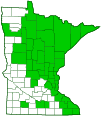inland serviceberry
(Amelanchier interior)
Conservation • Description • Habitat • Ecology • Use • Distribution • Taxonomy
|
|
||||||||||||||
Description |
Inland serviceberry is usually a large, 3′ to 40′ tall, deciduous shrub rising on multiple stems. Sometimes it is a small tree. It is usually solitary but sometimes forms a small colony. It occurs only in a narrow latitudinal range in eastern North America, from Nova Scotia and Maine, east to southern Ontario and Minnesota, and south to northern Illinois and Ohio. It is found in dry forests, fields, and thickets, and on hillsides, bluffs, and stream banks. It is sometimes also found in bogs. It grows under full or partial sun in moist to dry, sandy or sandy-loamy soil. Inland serviceberry is somewhat variable in appearance, having characteristics intermediate between other serviceberries, and having a large range of lengths of flower stalks (pedicels), floral leaves (sepals), and petals. What is now defined as inland serviceberry may be hybrid swarm involving smooth serviceberry, low serviceberry, and/or roundleaf serviceberry. The bark is thin, smooth, and gray. First year branchlets are greenish-brown, slender, flexible, and hairless. In the second year they are brown to reddish-brown with a few scattered, light-colored pores (lenticels). Terminal buds are up to ½″ long and sharply pointed. They are covered with reddish-brown scales which may be hairy, at least at the edges, or hairless. The leaves are alternate and are not fully developed at flowering time. Young leaves are green, slightly to moderately tinged with bronze, and hairy on the upper and lower surfaces. They are on ⅜″ to 1 3⁄16″ (10 to 30 mm) long leaf stalks (petioles). The petioles are hairy when young, becoming hairless or almost hairless when mature. Fully developed leaves are broadly egg-shaped to elliptic, 1 3⁄16″ to 2¾″ (30 to 70 mm) long, and ¾″ to 2″ (20 to 50 mm) wide. The leaf blades are rounded to almost heart-shaped at the base and taper to a point at the tip with concave sides along the tip. Sometimes they are broadly or narrowly angled at the tip and have a short, sharp, abrupt point. The upper surface is dark green and hairless. The lower surface is pale green and hairless or almost hairless. The margins have 21 to 40 short, sharp, forward pointing teeth on each side. The longest tooth is less than 1⁄32″ (1 mm) long. The basal half of each side has just 3 to 15 teeth. Larger leaves have at least 27 teeth per side. The upper (distal) half has usually 4 or 5 teeth every ⅜″ (1 cm). The inflorescence is an unbranched, 1 3⁄16″ to 3″ (30 to 75 mm) long cluster (raceme) of 4 to 12 flowers at the end of the stems and branches. The flowers appear from late April to early June when the leaves are just one-third to two-thirds grown and not completely unfolded. Each flower is on a hairless or almost hairless flower stalk (pedicel). The lower pedicels may be ⅜″ to 1¾″ long. At least 1 or 2 of the pedicels are subtended by a leaf. The flowers are large, about 1″ in diameter, and showy. They have both male and female reproductive parts. There are 5 sepals, 5 petals, 20 stamens, and 5 styles. The sepals are green, triangular, and short, 1⁄16″ to 3 ⁄16″ (2 to 5 mm) long. They are erect in flower, bent backward in fruit. The petals are white, inversely egg-shaped, ¼″ to ⅝″ (6 to 15 mm) long, and ⅛″ to 3⁄16″ (4 to 5 mm) wide. The ovary is densely hairy at the top. The fruit is a globe-shaped, ¼″ to 5⁄16″ (6 to 8 mm) in diameter pome with 4 to 10 seeds. It is green at first, becoming dark purple at maturity. |
Height |
3′ to 40′ |
Flower Color |
White |
Similar Species |
When in flower in the spring, inland serviceberry may be mistaken for American plum. The petals of inland serviceberry taper evenly to a narrowed base. The petals of American plum are clawed, tapering abruptly to a very narrow base. |
Habitat |
Moist to dry. Forests, fields, and thickets, hillsides, bluffs, and stream banks. Full or partial sun. Sandy or sandy-loamy soil |
Ecology |
Flowering |
Late April to early June |
Pests and Diseases |
|
Use |
|
Distribution |
||
|
Sources 2, 3, 4, 5, 7, 8, 24, 28, 29, 30. iNaturalist has a likely but unconmfirmed sighting in Scott County (light green on the map). |
|
| 7/9/2024 | ||
Nativity |
||
Native |
||
Occurrence |
||
Relatively common |
||
Taxonomy |
|
| Kingdom | Plantae (Plants) |
| Division | Tracheophyta (Vascular Plants) |
| Subdivision | Spermatophytina (Seed Plants) |
| Class | Magnoliopsida (Dicots) |
Order |
Rosales (Roses, Elms, Figs, and Allies) |
Family |
Rosaceae (Rose) |
| Subfamily | Amygdaloideae |
| Tribe | Maleae |
| Subtribe | Malinae |
Genus |
Amelanchier (serviceberries) |
Subordinate Taxa |
|
|
|
Synonyms |
|
| Amelanchier wiegandii | |
Common Names |
|
inland serviceberry Pacific serviceberry shadbush Wiegand’s shadbush |
|
Glossary
Elliptic
Narrowly oval, broadest at the middle, narrower at both ends, with the ends being equal.
Lenticel
A corky, round or stripe-like, usually raised, pore-like opening in bark that allows for gas exchange.
Pedicel
On plants: the stalk of a single flower in a cluster of flowers. On insects: the second segment of the antennae. On Hymenoptera and Araneae: the narrow stalk connecting the thorax to the abdomen: the preferred term is petiole.
Petiole
On plants: The stalk of a leaf blade or a compound leaf that attaches it to the stem. On ants and wasps: The constricted first one or two segments of the rear part of the body.
Pome
A fruit with a central seed bearing core enclosed in thick flesh, e.g., an apple or pear.
Raceme
An unbranched, elongated inflorescence with stalked flowers. The flowers mature from the bottom up.
Sepal
An outer floral leaf, usually green but sometimes colored, at the base of a flower.
Visitor Photos |
||
Share your photo of this plant. |
||
This button not working for you? |
||
Luciearl |
||
… It did get some small dark berries. Trunk yellowish. About 15 ft high. Grows on water’s edge. |
||
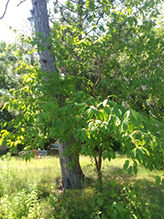 |
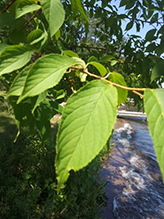 |
|
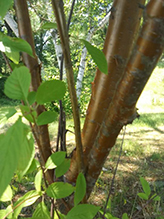 |
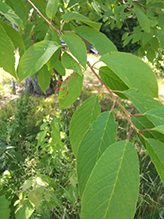 |
|
The white blooms against the bronze leaves are beautiful. |
||
 |
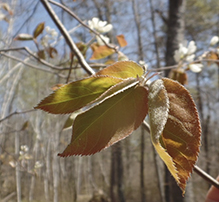
|
|
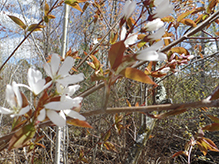 |
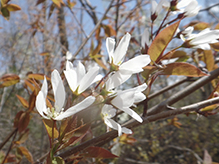 |
|
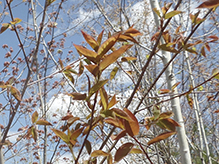 |
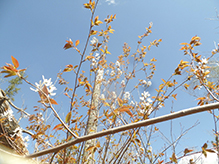 |
|
MinnesotaSeasons.com Photos |
||
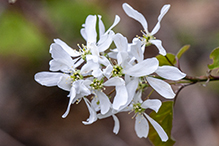 |
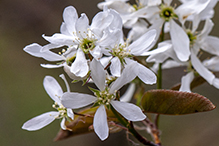 |

Slideshows |
|

Visitor Videos |
||
Share your video of this plant. |
||
This button not working for you? |
||
|
Other Videos |
||
Amelanchier, Serviceberry |
About
Mar 29, 2020 An introduction to the natural history of Amelanchiers, the serviceberries. This video describes how to identify serviceberry generally, how it differs from Callery pear, the animals that feed on amelanchier, how it is used in landscaping, and how it appears in the forest. The video briefly discusses hybrids, polyploidy, and aneuploidy. |

Visitor Sightings |
||
Report a sighting of this plant. |
||
This button not working for you? |
||
| Luciearl June 2024 |
Location: Lake Shore, MN … It did get some small dark berries. Trunk yellowish. About 15 ft high. Grows on water’s edge. |
 |
| Luciearl 5/15/2020 |
Location: Cass County The white blooms against the bronze leaves are beautiful. |
 |
MinnesotaSeasons.com Sightings |
||

Created: 6/1/2020 Last Updated: © MinnesotaSeasons.com. All rights reserved. |
